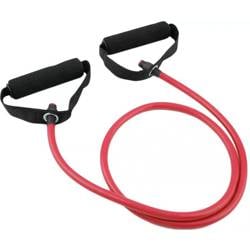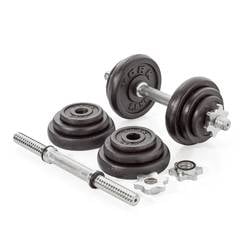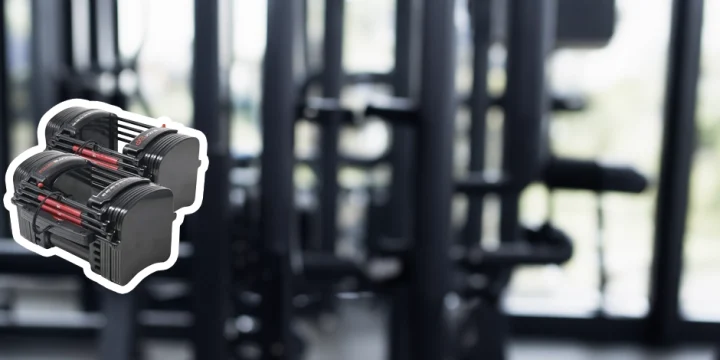When it comes to training with resistance bands vs. free weights, there always seem to be some misunderstandings.
I’ve encountered bodybuilders who believe resistance bands are their enemy for building muscle. And people who just want to gain some fitness often believe that free weights are totally unnecessary for their fitness exercises.
So I talked with other fitness experts and tested both resistance and free weights with a group of my clients.
Here's what you should know about each.
Quick Summary
- Choosing between resistance bands and dumbbells depends on your fitness goals, with bands offering gradual tension increase and portability and dumbbells providing consistent resistance and targeted muscle training.
- Resistance bands are versatile and cost-effective, ideal for a range of exercises and especially beneficial in rehabilitation due to their adjustable tension.
- According to Statista, the number of users of dumbbells and hand weights in the United States in 2022 was approximately 53.14 million.
- I find combining both resistance bands and dumbbells in a workout routine offers the best of both worlds, enhancing strength, flexibility, and overall fitness.
What Are Resistance Bands?

Resistance bands or band weights are a set of elastic rubber bands with grips at each end.
The bands also come in different colors, lengths, and sizes, with the combination of these three attributes defining their strength of the resistance bands when pulled.
Resistance bands are often a very cost-effective way to do resistance training, as they may achieve quite a wide range of resistance by combining different color bands.
This could take quite a lot of free weights to achieve. One reason bodybuilders don’t tend to exercise with resistance bands as much is that they provide variable resistance throughout the full range of motion of many exercises.
Thus, comparing resistance bands vs. free weight, resistance bands aren't able to provide maximum resistance throughout the body's range of motion.
What Are Free Weights?

Free weights are defined as any training load that is not connected to other gym apparatus. An example of a commonly used free weight is a dumbbell.
When it comes to the resistance bands vs. free weights debate, free weights evenly distribute the weight to provide better balance. They usually come in pairs to allow exercises with one free weight for each hand.
The top reason free weights are such a popular exercise tool is that they put a full strain on your muscles from the moment you start the movement.
However, there are very good reasons to introduce free weights and resistance bands together into your resistance and strength training. Let’s take a closer look at the advantages of resistance bands vs free weights.

Advantages Of Using Resistance Bands
There are five key benefits that you can get if you use resistance bands vs weights.
1 - Gradual Tension Increase
You’ll often find resistance bands used in rehabilitation training. The reason for this is that with many injuries, you may want to have a gradual increase in tension, which can be effectively provided by resistance bands [1].
Through this kind of weight-resistance training, the body has better control over the amount of strain produced on muscles and joints.
According to the Mayo Clinic, they can also be ideal for isometric exercise routines and strength and resistance training in the gym [2].
Related: Best Suspension Trainers
2 - Portability And Storage
The majority of resistance bands come in a small pouch, as the bands may be easily rolled up. Even a set of six resistance bands could be smaller than a handbag, which makes them much easier to store or bring with you when you travel. This way, you can exercise your muscles wherever you're going.
3 - Price
Typical resistance bands would probably cost you less than $20 for 5 or 6 resistance bands. Even with such a small set, you should be able to get a weight-equivalent range from 8 pounds all the way up to 50 pounds.
That’s a hell of a lot cheaper than a full set of weights.
4 - Safety
Some people may be afraid of resistance bands snapping and causing damage. I’ve yet to see that happen, and to be honest, when it comes to resistance bands vs weights and free weights, I’ve seen a lot more injuries when free weights or weights are used.
5 - Ideal For Compound Exercises
As a personal trainer, the reason I get my clients to take advantage of resistance bands on a regular basis is that you could plan some really good compound exercises.
According to a study in the National Library of Medicine, these target groups of muscles have been shown to be quite effective for building muscle [3].
However, with resistance bands, your movements may be a bit compromised by a limited range of motion.
These small, yet powerful tools are perfect for targeting small and large muscle groups and working with compound exercises. Plus, they're super easy to store at home or pack in a bag and take wherever you travel.
- Mallory Creveling, Fitness Writer
Advantages Of Free Weights

These are the five key advantages of using free weights.
1 - Highly Targeted Muscle Training
Once you have managed to get your body into reasonably good shape, you may want to start building muscle in a more targeted way. According to a study in Plos One Journal, when you're training with free weights, such as a dumbbell, you get to learn specific moves that only trigger a specific muscle [4].
From my journey of getting into shape and then shifting focus to muscle building, I've found free weights invaluable. They've allowed me to target specific muscle groups effectively, something I realized was crucial once I achieved a basic fitness level.
Add to that a large range of motion, and you could be in a much better position to shape your body the way you want it to look.
BowFlex and PowerBlock are two of the most popular adjustable dumbbells on the market. You can read our full review between BowFlex vs PowerBlock.
Related article: PowerBlock vs IronMaster adjustable dumbbells
2 - Provides Consistent Resistance
You’ll notice when it comes to resistance bands vs. free weights that free weights are much better suited to give you constant resistance throughout the workout you're performing.
With resistance bands, on the other hand, the resistance increases gradually, and you’ll only feel the full tension towards the end of a movement.
One thing I've consistently noticed, both in my workouts and when training clients, is the unmatched constant resistance free weights offer. This consistency is key for progressive overload, a principle I've relied heavily on for strength gains.
A bench press with a bar can cause serious injury or even death. For this reason, always use a spotter when lifting free weights.
-Richard Weil, Exercise Physiologist
3 - Better Focus On Endurance
Because of the consistent resistance, you might also gain better endurance as you may be able to stretch yourself to the limit. This means you may have better momentum while performing your workouts with free weights.
4 - Gain More Flexibility With The Types Of Moves
Most people also tend to use free weights at the gym because they introduce many types of workouts and moves. The effect of the added range of motion means that reps in every set increase the results you can achieve for a particular body part.
5 - More Accurate Equipment
What traditional weight equipment is great for is keeping exact track of how much you are actually lifting.
With a resistance band, quantifying weight progress may not be as objective.
Seeing the progress on paper with precise weights for your bench press or bicep curl allows you to better predict your results.
For example, if you're new to lifting, you may only be able to lift a small amount of weight on your first day. However, after two months with a lot of strength training, it's possible to lift more weights. And you get to see all these results in the paper.
But all this doesn’t mean you have to force yourself to choose one over the other.
Read More: 10 Best Dumbbell Rack Sets
Taking Advantage Of Both Types
You really shouldn’t be looking at your workouts and feel like it’s a decision of resistance bands vs weights. Both of them have very specific advantages, and you may be able to take advantage of the difference in uses.
For example, a bodybuilder could take advantage of resistance bands through specific isometric moves where maximum tension is held at the end of each rep. They might also help during a warmup and stretching routine to get your blood flowing to your muscles.
For someone looking to lose those unwanted pounds, traditional gym weights could be a great tool to tone up muscles and burn away some fat. You don’t have to go for something heavy to achieve some great results.
Essentially, whether you’re aiming for weight loss, fitness improvement, or bodybuilding, free weights, and resistance bands should become part of your workout equipment.
Sample Resistance Band Exercises

One thing to keep in mind is that you’ll likely need to switch around resistance band colors for progressive resistance and strength training. This will greatly help with fitness improvement.
Have them all laid out and ready, and as you complete some of these moves, write down the color combination that worked best.
- Chest Fly: For this, you’ll need to attach the band to a door frame. Hold the handles in each hand next to your shoulders and then move your arms in a wing-like motion to meet or join in front of you. This exercise does not involve your triceps but will help build chest strength.
- Pull-Ups: Again, attach the band to a door frame and from a kneeling position, pull the handles towards your chest. This exercise is a great way to practice the pull-up motion without straining your arms. It will also help increase the strength of your biceps, trapezius, and lats.
- Squats: Stand on the band with both feet and hold the handles about shoulder high. Then go through a set of standard squats. This is best for core strength benefits.
- Overhead Press: Start in a similar position as the squats. From here, extend your arm in the upward direction until fully stretched. This will help increase the strength of your shoulder muscle.
- Triceps Kickback: Lean forward in a runner pose and create a loop with the band under your foot. Angle your arms with your upper arm parallel to your torso. Extend both arms and hold for some isometric tension.
Also, you might want to check out our full-body resistance band circuit workout.
Sample Free Weights Exercises
With free weights, it’s all about letting gravity work it’s magic. As a personal trainer, I also recommend these exercises to my clients, and you’ll see this often at the gym.
The following are some of the more common sample moves that use a dumbbell:
- Bicep Curl: Stand with your feet shoulder-width apart and a dumbbell in each hand. Pull each weight in the upward direction in a slow and steady move. This exercise increases the strength of your arms, and also defining them.
- Tricep Extension: Stand straight and hold the weight over your shoulder with your elbow pointing straight up. Slowly extend your arm in the upward direction fully stretching it out, and make sure you don’t start with something too heavy.
- Upright Rowers: Standing upright, hold a free weight in each hand about hip-high. Then pull them upwards to just below your chin, and then slowly let gravity pull them down again. You might want to pick something heavy for this one. You get to burn more calories doing this move due to two or more muscles working together.
- Lawnmowers: Lean forward with one leg stretched out behind you. Support your weight by leaning on your knee with one arm. Use the other arm to pull up a free weight as if you’re trying to start a lawnmower. Be careful, though, as your back must remain perfectly straight.
- Shoulder Press: Hold a dumbbell in each hand at about shoulder height. Alternately push one weight up while fully stretching your arm. This workout targets the muscles on your shoulders, triceps, trapezius, and core, thereby increasing your fitness strength.
Specific Rehabilitation Uses of Resistance Bands and Dumbbells
Rehabilitation exercises play a crucial role in recovering from injuries and surgeries, and both resistance bands and dumbbells are valuable tools in this process.
However, their application varies depending on the nature of the injury and the stage of rehabilitation.
Resistance Bands in Rehabilitation
Here's how to use resistance bands in rehabilitation:
- Gradual load adjustment: Their elasticity allows for a gradual increase in load, which is essential for tissues that are healing. This adjustability helps in tailoring exercises to the specific needs and current capabilities of the patient.
- Joint-friendly movements: The smooth resistance offered by bands is gentler on the joints. This is particularly beneficial for patients recovering from joint surgeries or those with arthritis. The bands allow for a range of motion exercises that are crucial in regaining joint mobility.
- Functional movement patterns: Resistance bands are excellent for mimicking daily movement patterns. This aspect is particularly important for elderly patients or those recovering from significant motor function loss.
- Versatility in exercise: Bands can be used for a wide range of exercises targeting different body parts. This versatility is beneficial in rehabilitation, where a patient might need to work on multiple muscle groups or joints.
Dumbbells in Rehabilitation
Here's how to use dumbbells in rehabilitation:
- Strength building: As the patient progresses in their recovery, dumbbells become more useful for building strength. The fixed resistance they provide is essential for regaining muscle mass and strength, especially after prolonged periods of inactivity or muscle atrophy.
- Control and stability training: Dumbbells are excellent for exercises that require control and stability. They are particularly useful in the later stages of rehabilitation when the focus shifts to regaining full functional strength and coordination.
- Bone health: Weight-bearing exercises with dumbbells are beneficial for bone health. This is particularly important for patients recovering from bone injuries or surgeries, as well as for those dealing with osteoporosis.
- Progress tracking: The fixed weight increments of dumbbells make it easier to track progress in strength training. This can be motivating for patients, as they can see tangible improvements in their capabilities.
Durability and Maintenance of Resistance Bands and Dumbbells
Resistance bands and dumbbells, while durable, require different approaches to maintenance and care.
Resistance Bands: Ensuring Elasticity and Safety
Here's how to ensure the elasticity and safety of resistance bands:
- Regular inspection: Regularly check your bands for signs of wear and tear, such as small tears, discoloration, or a tacky feel. These can be early indicators that the band is losing its integrity and might need replacing.
- Proper cleaning: Clean your bands with a mild soap and water mixture, avoiding harsh chemicals that can degrade the material. After cleaning, dry them thoroughly before storing.
- Avoid overstretching: Do not stretch the bands beyond their recommended limit, usually around two and a half times their length. Overstretching can weaken the material and reduce the band's lifespan.
- Storage: Store resistance bands away from direct sunlight, as UV rays can degrade the material. Also, keep them in a cool, dry place to prevent the rubber from becoming brittle.
Dumbbells: Preserving Strength and Appearance
Here's how to preserve your dumbbells:
- Regular inspection: Check for any signs of rust, especially if you have iron dumbbells. Also, ensure that adjustable dumbbells' locking mechanisms are working correctly to prevent accidents.
- Cleaning: Wipe down dumbbells regularly to remove sweat, dust, and grime. For metal dumbbells, you can use a mild disinfectant. For rubber-coated ones, a damp cloth should suffice.
- Rust prevention: If your dumbbells are prone to rusting, consider using a silicone-based spray to protect them. However, be cautious not to get any on the grip to avoid slippage.
- Proper storage: Store dumbbells on a rack to prevent moisture buildup underneath them, which can lead to rusting. Avoid stacking them on top of each other, as this can cause wear on the coating.
- Handling with care: Dropping dumbbells can damage both the dumbbells and your floor. Use them with care, especially if they have a rubber or neoprene coating, which can crack on impact.
FAQ
Are resistance bands as good as dumbbells?
Yes, resistance bands may be as good as dumbbells for certain types of exercises. However, if you must choose between free weights vs resistance bands for targeted muscle training, then free weights might be better.
Can you build muscle with resistance bands?
Yes, you use resistance bands in building muscle. Resistance bands work best for strength and resistance training. When you hold a band at maximum tension through an isometric exercise, then you could be creating enough strain to trigger muscle growth.
Can you use resistance bands every day?
Yes, you can use resistance bands every day. At the same time, you would probably want to combine them with regular weights at the gym to get the best results out of your training time.
Do resistance bands burn fat?
Yes, resistance bands may burn fat if you use them for high-intensity and cardio exercising. But rather than pick between free weights vs resistance bands, you should come up with a workout routine that takes advantage of both.
References:
https://www.painscience.com/articles/strength-training.php https://www.mayoclinic.org/healthy-lifestyle/fitness/expert-answers/isometric-exercises/faq-20058186 https://www.ncbi.nlm.nih.gov/pmc/articles/PMC3820232/ - https://journals.plos.org/plosone/article?id=10.1371/journal.pone.0226989
About The Author
You May Also Like






